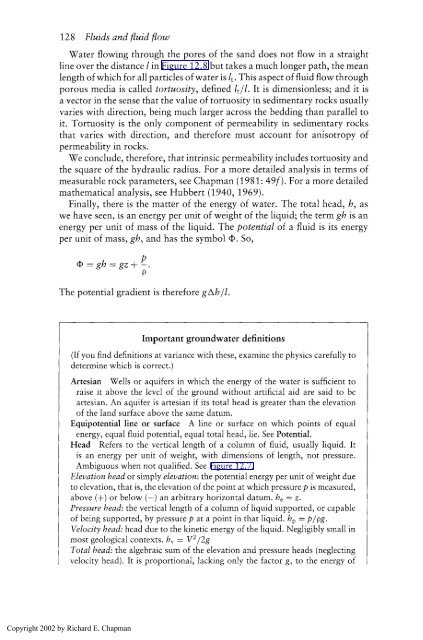Physics for Geologists, Second edition
Physics for Geologists, Second edition
Physics for Geologists, Second edition
You also want an ePaper? Increase the reach of your titles
YUMPU automatically turns print PDFs into web optimized ePapers that Google loves.
128 Fluids and fluid flow<br />
Water flowing through the pores of the sand does not flow in a straight<br />
line over the distance 1 in Figure 12.8 but takes a much longer path, the mean<br />
length of which <strong>for</strong> all particles of water is I,. This aspect of fluid flow through<br />
porous media is called tortuosity, defined 1,/1. It is dimensionless; and it is<br />
a vector in the sense that the value of tortuosity in sedimentary rocks usually<br />
varies with direction, being much larger across the bedding than parallel to<br />
it. Tortuosity is the only component of permeability in sedimentary rocks<br />
that varies with direction, and there<strong>for</strong>e must account <strong>for</strong> anisotropy of<br />
permeability in rocks.<br />
We conclude, there<strong>for</strong>e, that intrinsic permeability includes tortuosity and<br />
the square of the hydraulic radius. For a more detailed analysis in terms of<br />
measurable rock parameters, see Chapman (1981: 49f). For a more detailed<br />
mathematical analysis, see Hubbert (1940, 1969).<br />
Finally, there is the matter of the energy of water. The total head, h, as<br />
we have seen, is an energy per unit of weight of the liquid; the term gh is an<br />
energy per unit of mass of the liquid. The potential of a fluid is its energy<br />
per unit of mass, gh, and has the symbol @. So,<br />
The potential gradient is there<strong>for</strong>e gAh/l.<br />
Important groundwater definitions<br />
(If you find definitions at variance with these, examine the physics carefully to<br />
determine which is correct.)<br />
Artesian Wells or aquifers in which the energy of the water is sufficient to<br />
raise it above the level of the ground without artificial aid are said to be<br />
artesian. An aquifer is artesian if its total head is greater than the elevation<br />
of the land surface above the same datum.<br />
Equipotential line or surface A line or surface on which points of equal<br />
energy, equal fluid potential, equal total head, lie. See Potential.<br />
Head Refers to the vertical length of a column of fluid, usually liquid. It<br />
is an energy per unit of weight, with dimensions of length, not pressure.<br />
Ambiguous when not qualified. See Figure 12.7.<br />
Elevation head or simply elevation: the potential energy per unit of weight due<br />
to elevation, that is, the elevation of the point at which pressure p is measured,<br />
above (+) or below (-) an arbitrary horizontal datum. he = z.<br />
Pressuve head: the vertical length of a column of liquid supported, or capable<br />
of being supported, by pressure p at a point in that liquid. h, = plpg.<br />
Velocity head: head due to the kinetic energy of the liquid. Negligibly small in<br />
most geological contexts. h, = V2/2g<br />
Total head: the algebraic sum of the elevation and pressure heads (neglecting<br />
velocity head). It is proportional, lacking only the factor g, to the energy of<br />
Copyright 2002 by Richard E. Chapman






